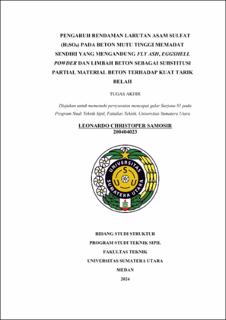| dc.description.abstract | In general, normal concrete constructions located underground and exposed to chemicals can cause damage to underground infrastructure, such as wastewater treatment plants, foundation structures, tunnels, and basements. However, problems often occur during normal casting processes, such as segregation between fine aggregates, water, cement, and coarse aggregates due to spacing between reinforcements and inadequate compaction using vibrators, which leads to damage to the concrete. A solution to address this compaction issue is through the use of High Strength Self-Compacting Concrete (HSSCC), which has a low water-cement ratio but offers a mix that is easily moldable and workable. However, producing HSSCC requires more cement, resulting in significant CO2 emissions that can impact the environment. The cement industry contributes approximately 7% of total CO2 emissions. This study uses fly ash and eggshell powder as partial cement substitutes and concrete waste as a partial substitute for coarse aggregates. The research method used is experimental, with cement substituted by varying fly ash at 0%, 5%, 10%, 15%, and 20% of cement weight and eggshell powder at 0%, 2%, 4%, 6%, and 8% of cement weight, while concrete waste was varied at 10% of coarse aggregate weight. In this study, the specimens were immersed in a 5% sulfuric acid (H2SO4) solution (pH=4.01), and then tensile strength tests were conducted at 14 and 28 days. The results of the study showed that the F5E2LB10 mix produced a tensile strength of 4.88 MPa at 28 days (5.62% or 0.0562 times stronger than normal SCC). However, increasing the amount of fly ash and eggshell powder reduced the tensile strength and workability of the concrete, increased viscosity, and reduced the filling ability and passing ability of HSSCC. | en_US |


